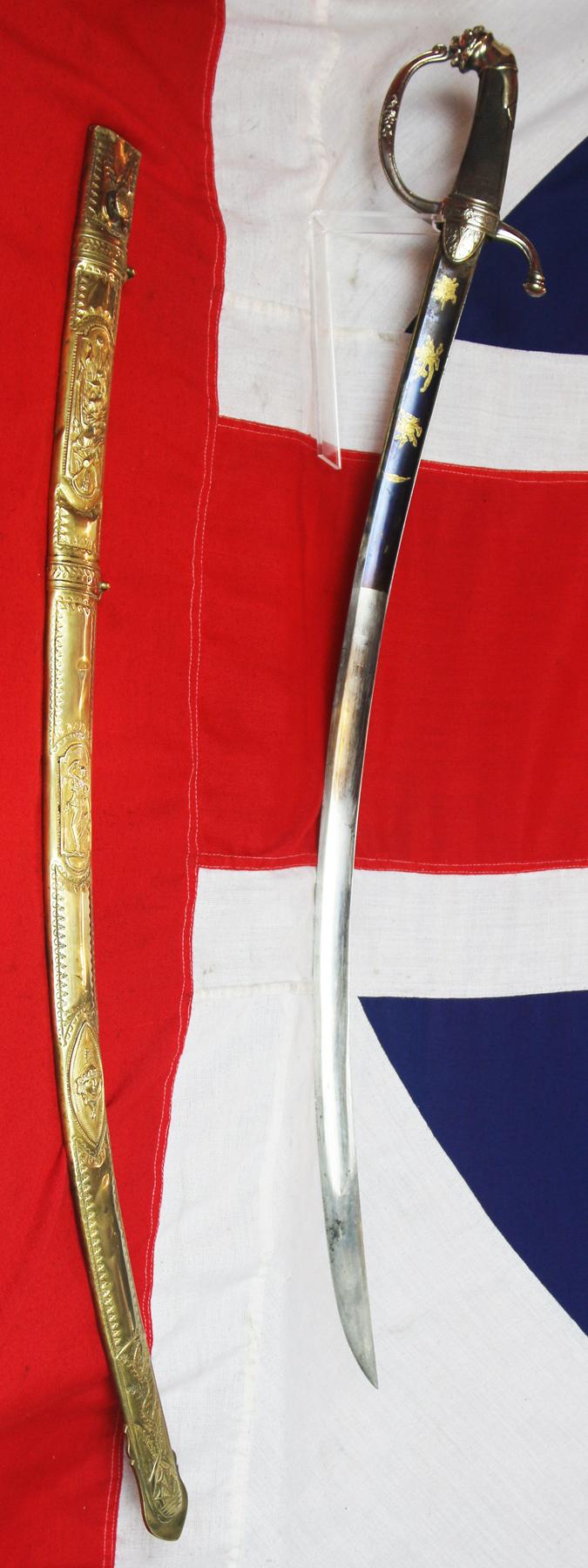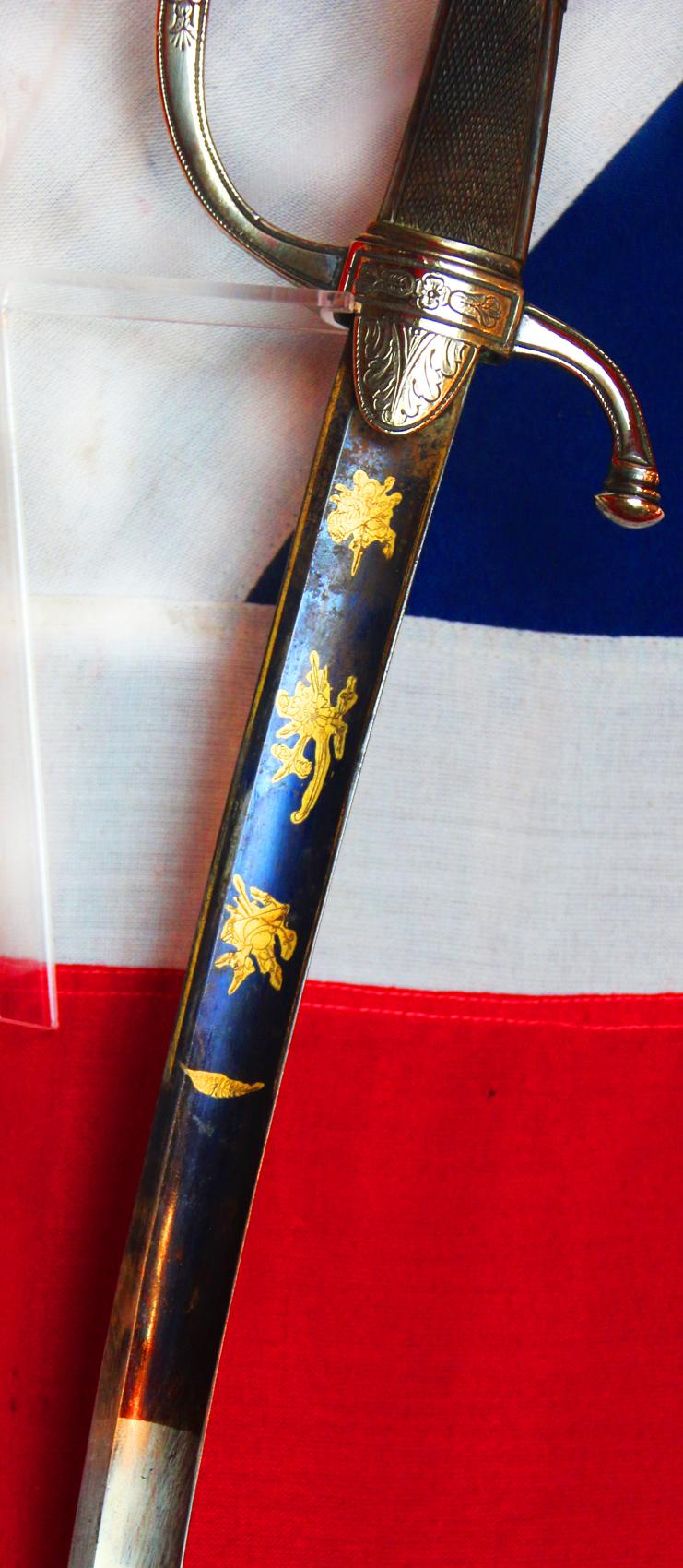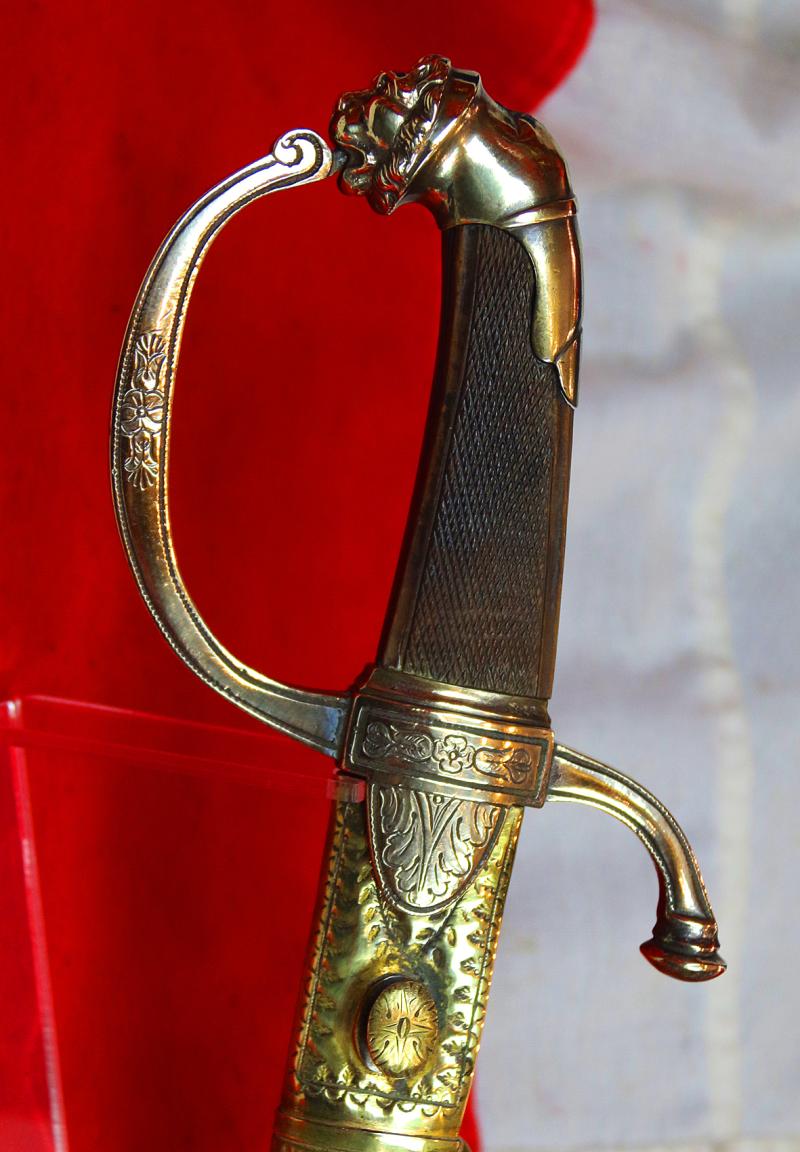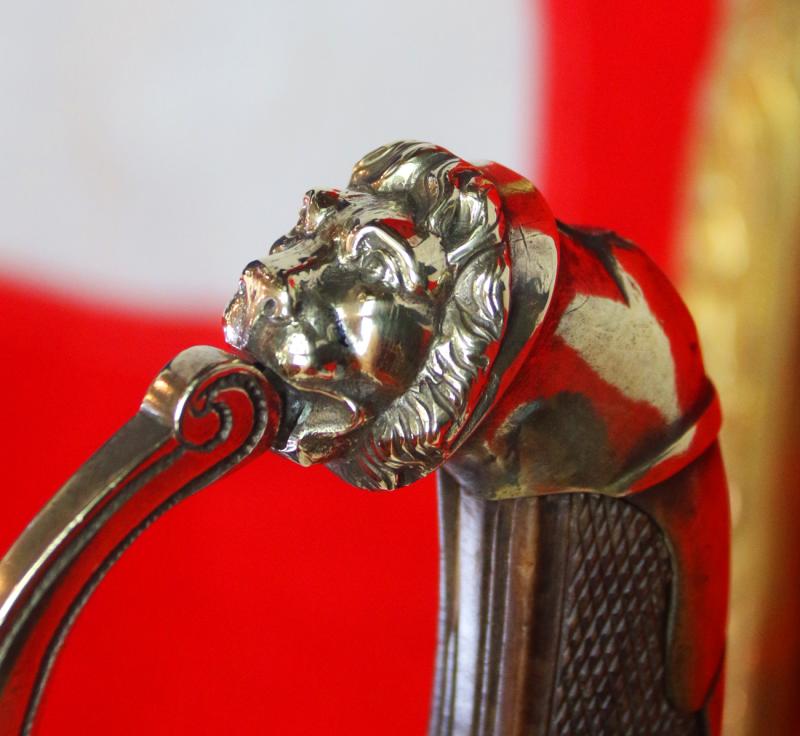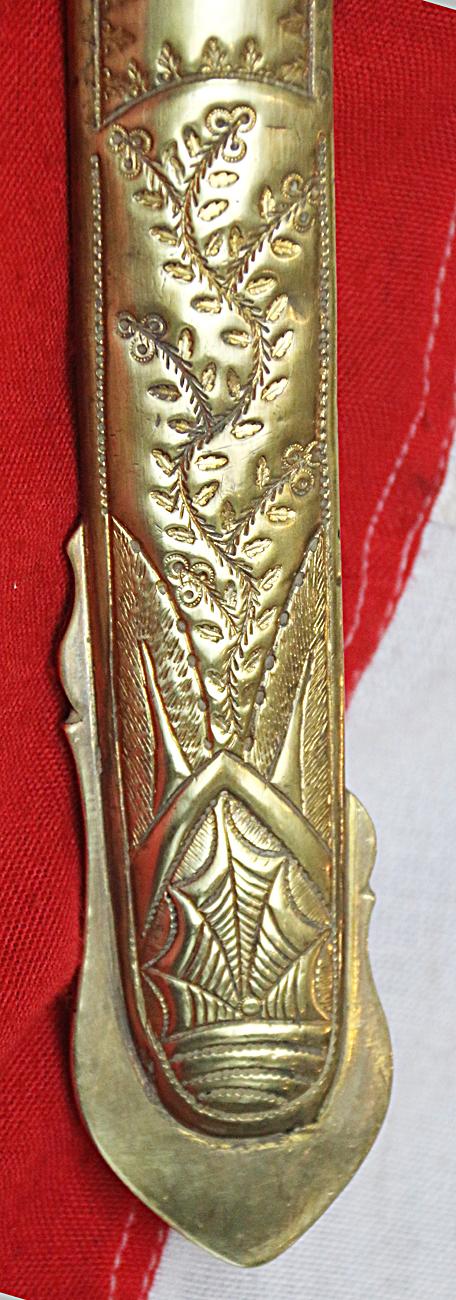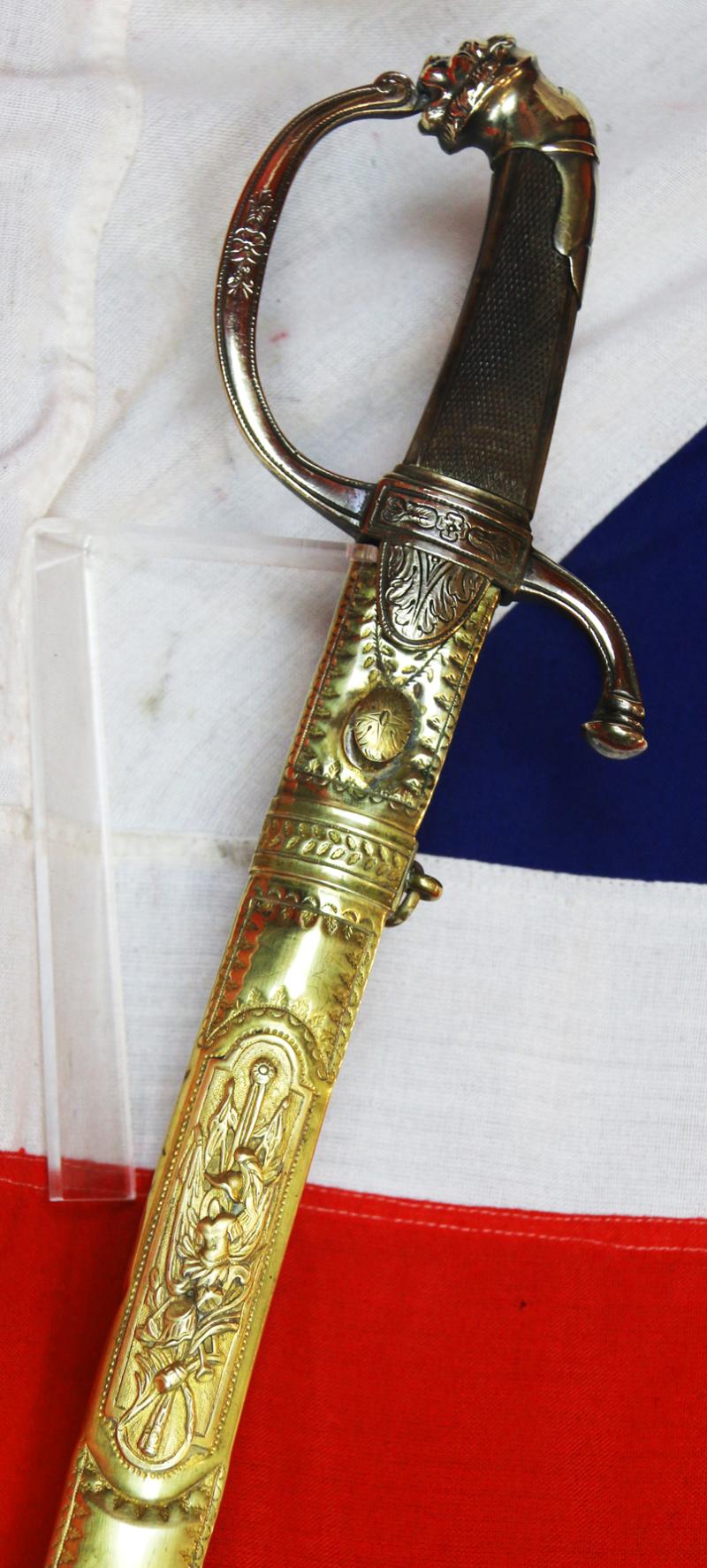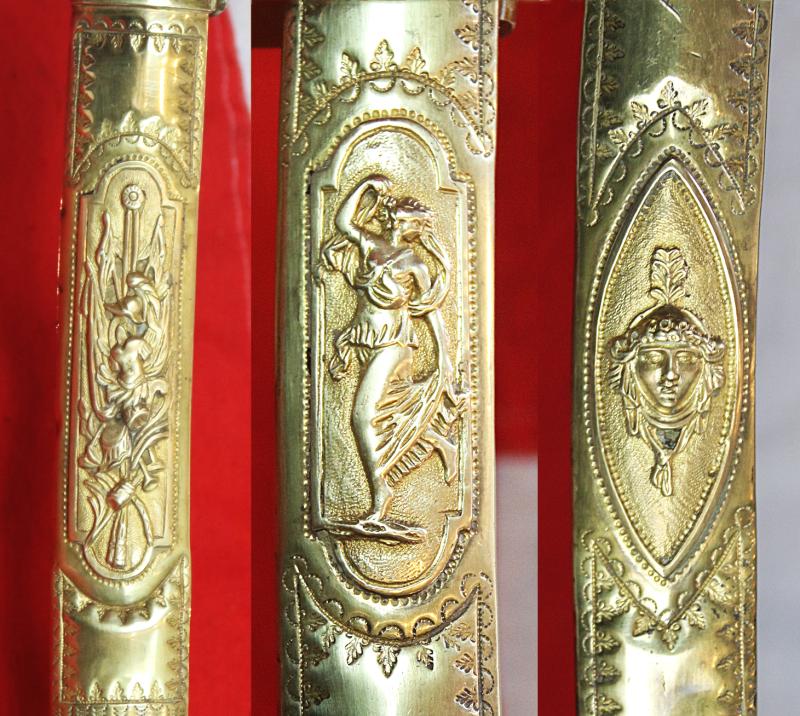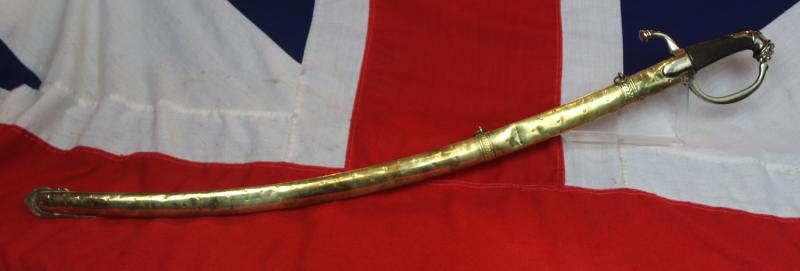A Superb, Rare, Museum Piece. An Original, French Napoleonic Wars Deluxe Grade Historical Sabre of a French General of Napoleon's General Staff, a Wonderful & Most Beautiful Sabre of Napoleon's Grand Armee. Consulate to Ist Empire Period
A general officer's 'blue and gilt' sword, with deluxe scabbard, that is very similar indeed to Napoleon's *Austerlitz Sword's scabbard, supposedly presented to Napoleon after Austerlitz, with the 'Cartouche médian au trophée avec tambours et piques' including classical figure panels of Victory standing and a portrait bust of the face of Minerva. the scabbard chape bears what the French called 'a la toile d'araignee sur les armes est anterieur a l'empire'. It is a spider's web, that was as a symbol used on superior arms in the Consular period. The spider symbolised the Biblical 'son' and the link that exists between the 'creator', and the 'creature', is the web that allows the second {the son} to reattach itself to the first {the creator} and, thus to get closer to it. In more simple terms the thread of the web constitutes the canvas which becomes a symbol of loyalty. The scabbard, amazingly has much of its remaining, original, mercurial gilt finish, that due to constant combat handling though, is no longer present on the hilt.
During the Revolutionary and Napoleonic Wars the French armies had approximately 2,000,000 plus serving soldiers, of those there were around 2000 generals commanding them in the armies of France, directly under their commander-in-chief, the Emperor Napoleon. However, for example, at the Battle of Borodino, Napoleon lost 1928 of his officer's including 49 Generals, in just one day!
This sword would have been used and carried in combat by one of those commanding generals of the general staff. Napoleon was, and remains, famous for his battlefield victories, and historians have spent enormous attention in analysing them.
In 2008, Donald Sutherland wrote:
The ideal Napoleonic battle was to manipulate the enemy into an unfavourable position through manoeuvre and deception, force him to commit his main forces and reserve to the main battle and then undertake an enveloping attack with uncommitted or reserve troops on the flank or rear. Such a surprise attack would either produce a devastating effect on morale, or force him to weaken his main battle line. Either way, the enemy's own impulsiveness began the process by which even a smaller French army could defeat the enemy's forces one by one.
After 1807, Napoleon's creation of a highly mobile, well-armed artillery force gave artillery usage increased tactical importance. Napoleon, rather than relying on infantry to wear away the enemy's defences, could now use massed artillery as a spearhead to pound a break in the enemy's line. Once that was achieved he sent in infantry and cavalry. The Napoleonic Wars brought radical changes to Europe, but the reactionary forces returned to power and tried to reverse some of them by restoring the Bourbon house on the French throne. Napoleon had succeeded in bringing most of Western Europe under one rule. In most European countries, subjugation in the French Empire brought with it many liberal features of the French Revolution including democracy, due process in courts, abolition of serfdom, reduction of the power of the Catholic Church, and a demand for constitutional limits on monarchs. The increasing voice of the middle classes with rising commerce and industry meant that restored European monarchs found it difficult to restore pre-revolutionary absolutism and had to retain many of the reforms enacted during Napoleon's rule. Institutional legacies remain to this day in the form of civil law, with clearly defined codes of law an enduring legacy of the Napoleonic Code.
While Napoleon is best known as a master strategist and charismatic presence on the battlefield, he was also a tactical innovator. He combined classic formations and tactics that had been used for thousands of years with more recent ones, such as Frederick the Great's "Oblique Order" (best illustrated at the Battle of Leuthen) and the "mob tactics" of the early Levée en masse armies of the Revolution. Napoleonic tactics and formations were highly fluid and flexible. In contrast, many of the Grande Armée's opponents were still wedded to a rigid system of "Linear" (or Line) tactics and formations, in which masses of infantry would simply line up and exchange vollies of fire, in an attempt to either blow the enemy from the field or outflank them. Due to the vulnerabilities of the line formations to flanking attacks, it was considered the highest form of military manoeuvre to outflank one's adversary. Armies would often retreat or even surrender if this was accomplished. Consequently, commanders who adhered to this system would place a great emphasis on flank security, often at the expense of a strong centre or reserve. Napoleon would frequently take full advantage of this linear mentality by feigning flank attacks or offering the enemy his own flank as "bait" (best illustrated at the Battle of Austerlitz and also later at Lützen), then throw his main effort against their centre, split their lines, and roll up their flanks. He always kept a strong reserve as well, mainly in the form of his Imperial Guard, which could deliver a "knockout blow" if the battle was going well or turn the tide if it was not.
Overall the condition is very good for age and considering its service. The scabbard has inner side surface contact denting, and the throat mount rim is lacking. In the 20th century generals plotted campaigns and were not often in the thick of combat. In the Napoleonic wars era generals fought, more often than not alongside their men in hand to hand combat, hence, Napoleon lost so many of his generals.
* The Sword given to Napoleon after his victory at Austerlitz appeared after 80 years in private hands in 2010, but hasn't been seen since.
Every single item from The Lanes Armoury, Britain's famous, favourite, and oldest original Armoury Antique store, is accompanied by our unique Certificate of Authenticity. Part of our continued dedication to maintain the standards forged by us over the past 100 years of our family’s trading, and thus, it is a lifetime guarantee.
Code: 25287


